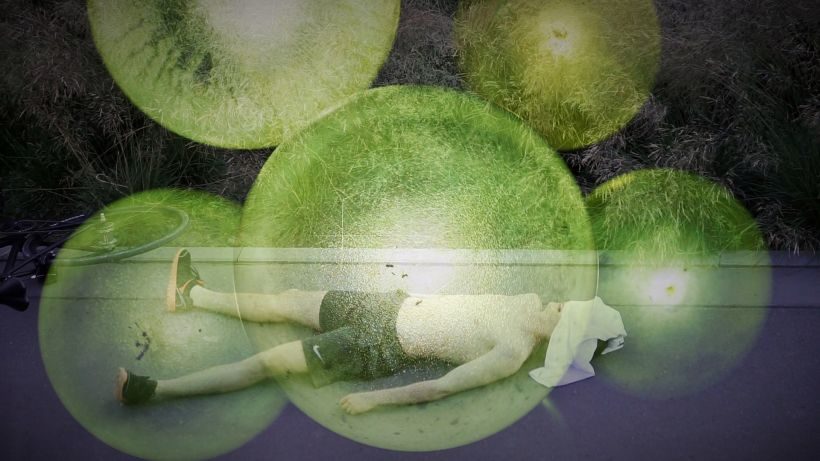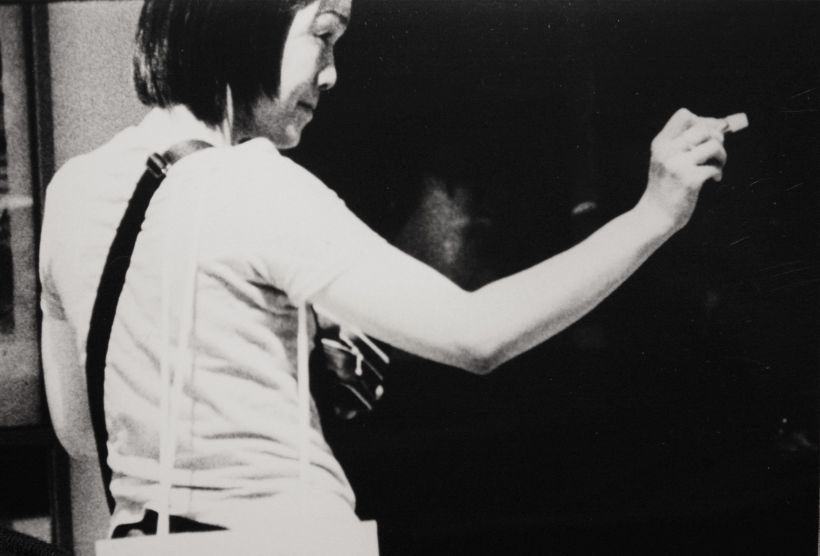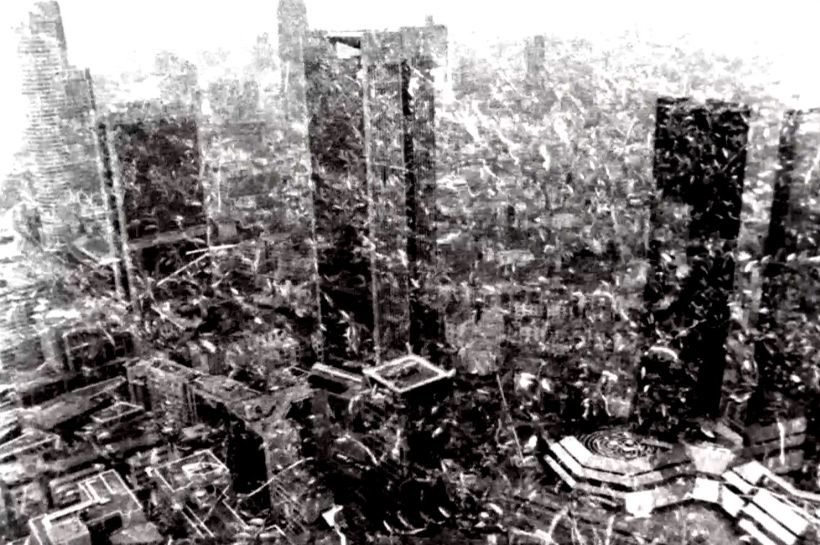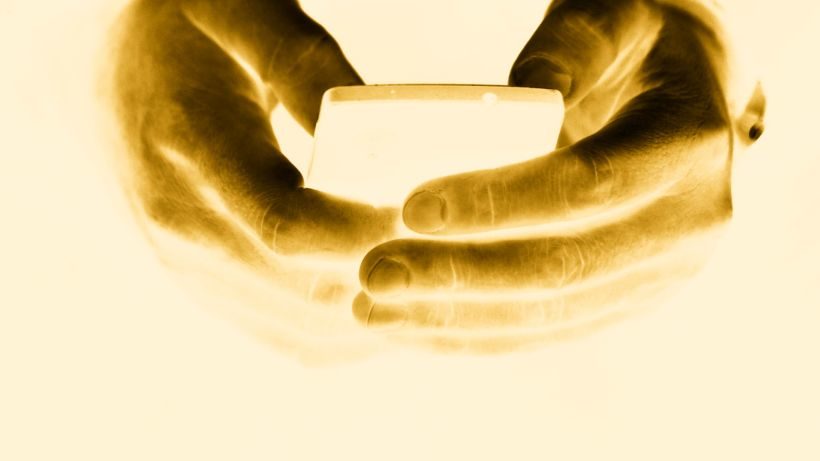
ONE ANOTHER, 2017/18 © Gunter Deller
Marvelling at the everyday, such as chance refractions of light, passing shadows, or a carelessly dropped handkerchief being blown by the wind almost gracefully across the ground – in the face of our fast-moving world, these brief observations of random phenomena seem to have ever-decreasing significance. With hardly any place left in our everyday lives for pausing and perceiving all that plays out quietly in our immediate surroundings. This is not so with Gunter Deller, who has made the marvelling at everyday phenomena his filmic practice. Up to 2014, his 16mm Bolex H16 film camera from the Swiss company Bolex Paillad was a constant companion on his daily rounds, with which he would capture exactly these unassuming occurrences and formulate them anew through artistic interventions. As a compact, easy-to-use camera with numerous animation features, the Bolex permits the shooting of experiments that can be further pursued on the editing table. For five years now, Gunter Deller has also shot on digital equipment. From analogue through to digital filmmaking, Gunter Deller’s cosmos and self-perception as a filmmaker are highly varied and diverse, yet for that they always revolve around observations of external reality and that can result as new associations from the editing of individual scenes.
In the mid-1980s, Gunter Deller headed for Frankfurt with his camera at hand to present filmic works to an audience in the “Mal Seh’n Kino” workshop cinema, as it was called. Just a few years later, he would start working as a projectionist in this arthouse cinema founded by filmmakers and film lovers. He has remained loyal to the cinema to the present day, where he is the programme head by now. The cinema in the city on the River Main has established itself as a place that aims to do justice to the differing facets of cinema, and in which short films are also repeatedly included in the screening programmes.
All of the experimental short films by Gunter Deller follow his aspiration of creating a lasting cinematic occurrence. For Gunter Deller, the source of every idea is to be found in the direct observation of external reality, which he attains without taking long circuitous routes, such as via a screenplay, for instance, or by having a prior search for a location or protagonists. Unplanned, spontaneous observations form the subject matter in his visual language, thus becoming a poetic exploration of his immediate surroundings, which he arranges in his short films and creates new levels of meaning doing so. The impulse to capture a specific situation filmically is reflexive, as Gunter Deller explains, and solely determined by the conserving of a moment, setting it in relation to others and thus potentially formulating it anew.
Apart from these poetic explorations, he is known for his flicker films, which fall into the category of visual exercises and refer to the film medium. Positive and negative images are arranged in sequences and create a riveting effect right through to the projection surface. With the filmmaking process always resonating within them, the Bolex camera is the transporter of the negative stock, on which the trace of light inscribes itself forever and thus permits a moment in time to be conserved; yet also his short films shot on digital equipment are characterised by the use of an array of filmic means, such as edits, superimpositions or artificial black pauses, for instance. Doing so, the emulsion side of the film strip accords the bearer – the roll of film – a three-dimensionality and opens up a depth of space that repeatedly offers new opportunities for exploration. In this way, even the flurry of particles in the film stock becomes interesting and considered. The editing sequences undertaken by Gunter Deller are consequential attempts, so-to-speak, at finding new formulations. In this regard, the editing can be indicative of direct interventions, such as the slowing down of images through to single frames, or even the subsequent processing of the film footage with scratches for instance. But it always signifies the extricating of the filmed situation from its context and its embedding in an alternative narrative.
Schattengrenze

SCHATTENGRENZE, 1999 © Gunter Deller
For his experimental 16mm black and white short film “Schattengrenze” from 1999, Gunter Deller received the Hessian University Film Award. Marcel Daemgen was responsible for the abstract film music score. In the first shot of the almost 9-minute long film, a white landscape emerges slowly from out of the darkness, a wrinkling white sheet reminiscent of rough icebergs in Antarctica, above which a flickering cone of light passes by. The flickering light also defines the next scene by circling and floating across fir trees moving in the wind. Here, however, the space-time continuum becomes accelerated, with the movements of the branches acquiring drama through the quick-motion effect. The scene after this captures everyday life in a big city, with the movements of the hastening passers-by slowed down in turn. And even cars are pushing their way sluggishly through the slow-moving city traffic, before the camera pauses briefly on a paper handkerchief lying on the ground, which is ultimately picked up by the street cleaners and thus disappears from our field of vision. The grasp of the lipstick is observed to the same extent as the crackling of a plastic bag, or a fleeting touch by two people in the midst of these city occurrences. With nature shots displacing the scenes in the urban space again and again. The speed of the editing increases over the course of the film, with the music underscoring it ultimately permitting thoughts of heavy, rapid breathing. Everything becomes increasingly out of tilt, as the city and nature overlap and condense more and more, until they eventually become as one. The interaction of the short scenes, which lives from the increasing dynamics of the successive sequences and the rhythmisation of the images, as well as from the lighting mood, permits the short film to become a visual experience that gets by without a clear, unfolding plot. Rather, it consists solely of the sequential arranging of everyday observations and the bringing together of the two spaces, city and nature.
Eisgrub

EISGRUB, 2004 © Gunter Deller
The black and white short film “Eisgrub” (2004), which was also shot on 16mm, again reveals scenes from urban spaces. The camera perspective chosen is above the occurrences, which permits a sense of surveillance. Overall, three light exposure levels are connected flickeringly with each other, the cuts are short, as if through a prism or a snow globe, in which the brief sequences emerge in a vaguely discernible manner from the alternating light moods. In order to create white noise out of the electronic sounds underscoring this, scratches and marks were added to the complete optical soundtrack. This and further of his short films reveal Gunter Deller’s fascination with plays on light and shadow, with both of them forming the prerequisite for his filmmaking, in which a trace of light is inscribed into the film footage and the transfer from the physical world first becomes possible. In Deller’s short films, the footage, the roll of film, is significant to the same extent as the content conserved on it.
hier und da
His more recent digitally shot experimental films include “hier und da”, for which thoughts about travelling formed the starting point. What does it mean for people to be forced to leave their homeland and move to somewhere alien? How do they get from one place to the next nowadays, and do we ever reach our destination on a long journey? Borne by a melancholy film score, which is supported by a chorus of voices, again everyday observations are arranged loosely together. The sounds were added subsequently, most of which are aural sequences freely available on the internet. Shot in Frankfurt and Greece, the sea is just as present as is the skyline of the city on the River Main. Black and white shots displace vivid colourful sequences, with the light playing a leading role yet again here, as indeed do the atmospheric plays on colour, which generate images and moods that are barely graspable anymore.
One another

ONE ANOTHER, 2017/18 © Gunter Deller
In his digital short film “One another” from 2017, Gunter Deller’s interest in creating atmospheres through the interplay of short filmically documented everyday scenes is combined with the use of sound and light editing to evoke new associations. In the opening sequence, a snapshot emerges from a yellow surface, with the camera focusing on a young woman who at that moment is engrossed in applying her mascara. The next scene is defined by distorted sounds, in which brief black pauses interchange with instances concentrating on the clamour of pigeons under a bridge. The images merge into each other faster and faster, before digital geometric figures fill the frame and our view eventually comes to rest on a smartphone. The question of how we become connected with each other determines the editing of the sequences, in which day meets night, land meets the sea and emptiness meets community. Through the arrangements he takes, Gunter Deller succeeds – without words or a concrete plot – in ascribing new potential meanings to his everyday observations and revealing new interrelations between them.. These are formulated as questions that can be negotiated individually and which first become visible through the revelation of the process of filmmaking.
In his experimental short films, over the years Gunter Deller has depicted an amazing pool of everyday phenomena, ones that also always taken up new trends that are critically questioned by filmmakers, and to some extent with sequences from several years interconnected in his short films. Thus, it seems almost consequential that Gunter Deller has also applied himself to digital filmmaking and is exploring the new filmic opportunities linked to this. In this regard, the editing of the scenes, the subsequent formulating and assembling, destroys the illusion in the flicker films especially that this solely concerns a reflection or depiction of reality. The editing effected and the subsequent reordering permits the newly assembled film-reality to raise its claim to autonomy, which for Gunter Deller best becomes visible through contrasts: As darkness encounters light over and again for him, the city encounters nature, and velocity encounters standstill. With the filmmaker negotiating the assembly of the individual frames anew to become a movement and thus a narrative. He interweaves spatial constellations, colours or alternating light intensities in such a way that they create new impressions, yet do not conceal the process of filmmaking itself at the same time. In this way, the everyday becomes a place of marvels once more, in which everything is possible and permits itself to be assembled at random, yet without forgetting its origins.
Filmography:
INSELN VON DUNKELHEIT, INSELN VON LICHT – DER DICHTER
PAULUS BÖHMER, 2019
ONE ANOTHER, 2017/18
HIER UND DA, 2016
NEST:FLUCHT & FOUND FOOTAGE MONTAGEN, 2000/2016
LANDUNGEN UND PERIPHERE ZIELE, 2015
BATTLEFIELDS, 2014
BITS & BYTES, 2014
C+M+B, 2014
CONTACT HIGH COUNTERPART, 2014
KILLER INSTINCT, 2014
UNE PARTIE DE CAMPAGNE, 2014
WINTERJUNE, 2014
FRAGILE FOSSILE, 2014
THE FORGETTING OF INTENTIONS AND IMPRESSIONS,2013
IRREALE AREALE, 2013
LIGHT MY FIRE, 2013
WILDWECHSEL, 2012
RIVERRUN AND TOUCHDOWN, 2009
SCHLAFENDE HUNDE, 2007
ÖRTLICHE BETÄUBUNG, 2006/07
EISGRUB, 2004
SCHIEBT SHIPS, 2001
SCHATTENGRENZE, 1999
IM BLUMENGARTEN, 1999
IM HANDUMDREHEN, 1995
VON HIER AUS, 1995
ANDERE ORTE, 1994
INSELN, 1993
FLUCHTEN, 1993
RÄUME, 1989
1 Trackback